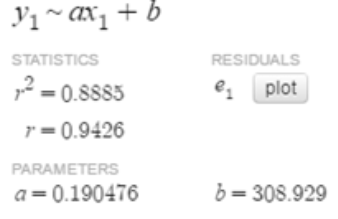
Concept explainers
(a)
To find: The equation of the best line fit with the help of graphing calculator.
(a)
Answer to Problem 11CT
The equation for the best fit line is
Explanation of Solution
Given:
The given table is shown in Table 1
Table 1
| Advertising (dollars )x | Yearly attendance, y |
| 500 | 400 |
| 1000 | 550 |
| 1500 | 550 |
| 2000 | 800 |
| 2500 | 650 |
| 3000 | 800 |
| 3500 | 1050 |
| 4000 | 1100 |
Calculation:
Input the values shown in Table 1 in the calculator and the result obtained is shown in Figure 1

Figure 1
Thus, the equation for the best fit line is
(b)
To find: The interpretation for the
(b)
Answer to Problem 11CT
The value of
Explanation of Solution
Given:
The given table is shown in Table 1
Table 1
| Advertising (dollars )x | Yearly attendance, y |
| 500 | 400 |
| 1000 | 550 |
| 1500 | 550 |
| 2000 | 800 |
| 2500 | 650 |
| 3000 | 800 |
| 3500 | 1050 |
| 4000 | 1100 |
Calculation:
From part (a) the correlation coefficient obtained is 0.9426. The value is close to 1 that means that the linear model is the good fit.
(c)
To find: The expectation for the
(c)
Answer to Problem 11CT
The scatter plot is supposed to be evenly dispersed about the horizontal axis.
Explanation of Solution
Given:
The given table is shown in Table 1
Table 1
| Advertising (dollars )x | Yearly attendance, y |
| 500 | 400 |
| 1000 | 550 |
| 1500 | 550 |
| 2000 | 800 |
| 2500 | 650 |
| 3000 | 800 |
| 3500 | 1050 |
| 4000 | 1100 |
Calculation:
From the value of the correlation the model is the good fit and being a good fit the expected scatter plot must be evenly dispersed about the horizontal axis.
(d)
To find: Whether there is any causal relationship in the data.
(d)
Answer to Problem 11CT
The number of people attending is proportional to the number of people viewing the advertisement.
Explanation of Solution
Given:
The given table is shown in Table 1
Table 1
| Advertising (dollars )x | Yearly attendance, y |
| 500 | 400 |
| 1000 | 550 |
| 1500 | 550 |
| 2000 | 800 |
| 2500 | 650 |
| 3000 | 800 |
| 3500 | 1050 |
| 4000 | 1100 |
Calculation:
From the given data shown in Table 1 the casual relationship that arise is that, more the number of people know about the advertisement the more they attend the festival.
Thus, the number of people attending is proportional to the number of people viewing the advertisement.
(e)
To find: The prediction for the amount that must be spent on the advertising to get 2000 people to attend the festival.
(e)
Answer to Problem 11CT
The amount that must be spent is
Explanation of Solution
Given:
The given table is shown in Table 1
Table 1
| Advertising (dollars )x | Yearly attendance, y |
| 500 | 400 |
| 1000 | 550 |
| 1500 | 550 |
| 2000 | 800 |
| 2500 | 650 |
| 3000 | 800 |
| 3500 | 1050 |
| 4000 | 1100 |
Calculation:
From the given data, consider the equation for the best fit is
Then,
Thus, the amount that must be spent is
Chapter 4 Solutions
BIG IDEAS MATH Algebra 1: Common Core Student Edition 2015
- Solve questionsarrow_forwardPatterns in Floor Tiling A square floor is to be tiled with square tiles as shown. There are blue tiles on the main diagonals and red tiles everywhere else. In all cases, both blue and red tiles must be used. and the two diagonals must have a common blue tile at the center of the floor. If 81 blue tiles will be used, how many red tiles will be needed?arrow_forwardFind the values of n, if the points (n + 1, 2n), (3n, 2n + 3) and (5n + 1,5n) are collinear. Find the value of k that the four points (4,1,2), (5, k, 6), (5,1,-1) and (7,4,0) are coplanar. Find the value of r if the area of the triangle is formed by the points (-3,6),(4,4) and (r,-2) is 12 sq units. Find the volume of tetrahedron whose vertices are A(1,1,0), B(-4,3,6), C(-1,0,3) and D(2,4,-5).arrow_forward
- - Consider the following system of linear equations in the variables a,b,c,d: 5a-3b 7c - 2d = 2 2ab 2c+ 5d = -3 → (*) 4a 3b 5d = 3 6a b+2c+ 7d = −7 (a) Solve the system (*) by using Gauss elimination method. (b) Solve the system (*) by using Cramer's rule method.arrow_forwardSolve for a 25 55 30 a=?arrow_forward9:41 … 93 Applying an Exponential Function to Newton's Law of Cooling 60. Water in a water heater is originally Aa ← 122°F. The water heater is shut off and the water cools to the temperature of the surrounding air, which is 60°F. The water cools slowly because of the insulation inside the heater, and the value of k is measured as 0.00351. a. Write a function that models the temperature T (t) (in °F) of the water t hours after the water heater is shut off. b. What is the temperature of the water 12 hr after the heater is shut off? Round to the nearest degree. c. Dominic does not like to shower with water less than 115°F. If Dominic waits 24 hr. will the water still be warm enough for a shower? Mixed Exercises ger-ui.prod.mheducation.comarrow_forward
- Please use the infinite series formula and specify how you did each step. Thank you.arrow_forward8) Solve the given system using the Gaussian Elimination process. 2x8y = 3 (-6x+24y = −6arrow_forward7) Solve the given system using the Gaussian Elimination process. (5x-4y = 34 (2x - 2y = 14arrow_forward
- 33 (a) (b) Let A(t) = = et 0 0 0 cos(t) sin(t) 0-sin(t) cos(t)) For any fixed tЄR, find det(A(t)). Show that the matrix A(t) is invertible for any tЄ R, and find the inverse (A(t))¹.arrow_forwardUse the infinite geometric sum to convert .258 (the 58 is recurring, so there is a bar over it) to a ratio of two integers. Please go over the full problem, specifying how you found r. Thank you.arrow_forwardH.w: Find the Eigen vectors for the largest Eigen value of the system X1+ +2x3=0 3x1-2x2+x3=0 4x1+ +3x3=0arrow_forward
 Algebra and Trigonometry (6th Edition)AlgebraISBN:9780134463216Author:Robert F. BlitzerPublisher:PEARSON
Algebra and Trigonometry (6th Edition)AlgebraISBN:9780134463216Author:Robert F. BlitzerPublisher:PEARSON Contemporary Abstract AlgebraAlgebraISBN:9781305657960Author:Joseph GallianPublisher:Cengage Learning
Contemporary Abstract AlgebraAlgebraISBN:9781305657960Author:Joseph GallianPublisher:Cengage Learning Linear Algebra: A Modern IntroductionAlgebraISBN:9781285463247Author:David PoolePublisher:Cengage Learning
Linear Algebra: A Modern IntroductionAlgebraISBN:9781285463247Author:David PoolePublisher:Cengage Learning Algebra And Trigonometry (11th Edition)AlgebraISBN:9780135163078Author:Michael SullivanPublisher:PEARSON
Algebra And Trigonometry (11th Edition)AlgebraISBN:9780135163078Author:Michael SullivanPublisher:PEARSON Introduction to Linear Algebra, Fifth EditionAlgebraISBN:9780980232776Author:Gilbert StrangPublisher:Wellesley-Cambridge Press
Introduction to Linear Algebra, Fifth EditionAlgebraISBN:9780980232776Author:Gilbert StrangPublisher:Wellesley-Cambridge Press College Algebra (Collegiate Math)AlgebraISBN:9780077836344Author:Julie Miller, Donna GerkenPublisher:McGraw-Hill Education
College Algebra (Collegiate Math)AlgebraISBN:9780077836344Author:Julie Miller, Donna GerkenPublisher:McGraw-Hill Education





